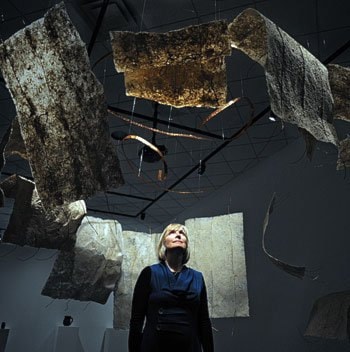Stones made of paper, baby clothes sewn from vintage curtains, and roses cast in porcelain are some of the surprising moments in the three solo shows that Helen O’Connor, Michele Karch-Ackerman and Rosemary Scanlon present at the Yukon Arts Centre.
Each artist explores how personal investment in a private iconography is shaped by collective experiences, some positive and some that need to be reclaimed.
The opening night for Salutation (O’Connor, Yukon), Foundling (Karch-Ackerman, Ontario), and The Rose Parade (Scanlon, Yukon) was a unique time to see the works. That afternoon, O’Connor brought a performance into her “Singing Stones” installation.
The sculpted stones are hollow and lightweight, in creamy hues. Helene Beaulieu played classical guitar while Monique Romieko danced with the stones, sometimes around them, sometimes lifting them. Seen now without the dance piece, a beautiful contrast continues between the heaviness implied by the boulder shapes and the translucent surfaces.
O’Connor built the stones by preparing a paper pulp of willow and gampi (a Japanese shrub) and placing the fibrous mixture over glacial erratics at Primrose Lake. When dry, she removed them so gently that their shape remains, like a three-dimensional portrait of another location.
Flax, hemp and seaweed are other fibres O’Connor has used for paper and sculpture over the years. For “Objects of Memory,” she layered household items like a frying pan with a pulp of pounded cotton fibre. As with “Singing Stones,” she removed the cast shape when it dried. These sculptures are matte black, resting on a shelf like shadows of working objects stilled at day’s end.
Restfulness plays a role in “Release,” too. O’Connor collaborated with photographer Martin Berkman to make a video of willow catkins bursting out of a sculpted paper form. Projected against two “screens” of handmade paper, the images enlarge when they splash against the larger, farther sheet, and expand even more on the gallery wall behind. It’s mesmerizing and elegant.
Foundling is Michele Karch-Ackerman’s installation piece that contemplates, and reframes, the experience of Canadian women who were sent away “to visit an aunt” (or other such fictions) when they were pregnant before marriage. She used vintage curtains to sew one hundred onesies for the infants that these mothers were denied the chance to raise.
The onesies are sewn from identical patterns. They hang in two rows, their shoulders about six feet off the ground.
They are arranged by colour. But walking between the rows, the individual textures enfold the visitor’s field of vision, as if to honour the historical mothers’ cloudy situation of wondering, “How did my child turn out? How does she smile? How does he sleep?”
Beside the sleepers, a long, narrow table holds 45 teacups from the 1930s to the 1970s. Again, they are organized by colour, so each blends as closely as possible to its neighbour. Again, item-by-item details fascinate, but only exist as part of the group.
The reason for this compression of individuality emerges at the row of card tables near the wall. Each holds a cream and sugar set and a framed “Rules and Regulations” sheet for “Rescue Homes.”
The women were denied private selfhood during their pregnancies. All were considered “fallen women”; in some institutions, the mothers-to-be were given aliases or numbers and did not even know each other’s names. It is the refusal of this shaming that motivates Karch-Ackerman’s work.
Rosemary Scanlon reaches back to earlier iconographies as one stream of influences for the watercolours, inkjet prints and sculptures in The Rose Parade. When Scanlon lived in Glasgow, Scotland, earning her Masters of Fine Arts, she was invited to interpret some works in the Burrell Collection, which has many tapestries. Scanlon adopts the flat perspective of tapestries and wallpapers - narrative scenes where distant and nearby objects are the same size - to give her images a dreamlike feel.
Most of Scanlon’s scenes are set outdoors. Flowers, animals, chairs and other entities hover against darkness as if against a night sky or, again, a dreamworld version of unpopulated space.
Familiar moments from Yukon life appear and morph in Scanlon’s watercolours. She paints smoke wafting from a small log cabin or multiple racks of antlers, then mixes in owls pondering blossoms, bears floating down from their constellation cousins in the stars, or stacks of cars towering to humorous heights.
Scanlon handles watercolour masterfully. She turns to inkjet prints to make backdrops with intense, uniform blacks that give sharper contrast between colours. A crisp, snowpacked mountain peak against rich black in “Stanchion,” for example, becomes a mysterious backdrop for the alluring, deliberately artificial blue, butter-yellow and wine-red roses.
Delicate porcelain roses sit on a plinth in the centre of The Rose Parade. Uncoloured, they seem the most fake, but they are the most literal objects in the room: they’re made by dipping real roses into porcelain slip and burning the organic matter away in the kiln.
Arranged on a layer of gold leaf, the piece is simply called “Roses.” Like the botanical and animal creatures in the other works, Scanlon’s roses reflect how humans are fascinated with the natural world both in raw form and in artificially, beautifully skewed states.
The exhibitions by O’Connor, Karch-Ackerman and Scanlon continue until May 10.
Meg Walker is a visual artist and writer absorbed in the colours of Dawson City
